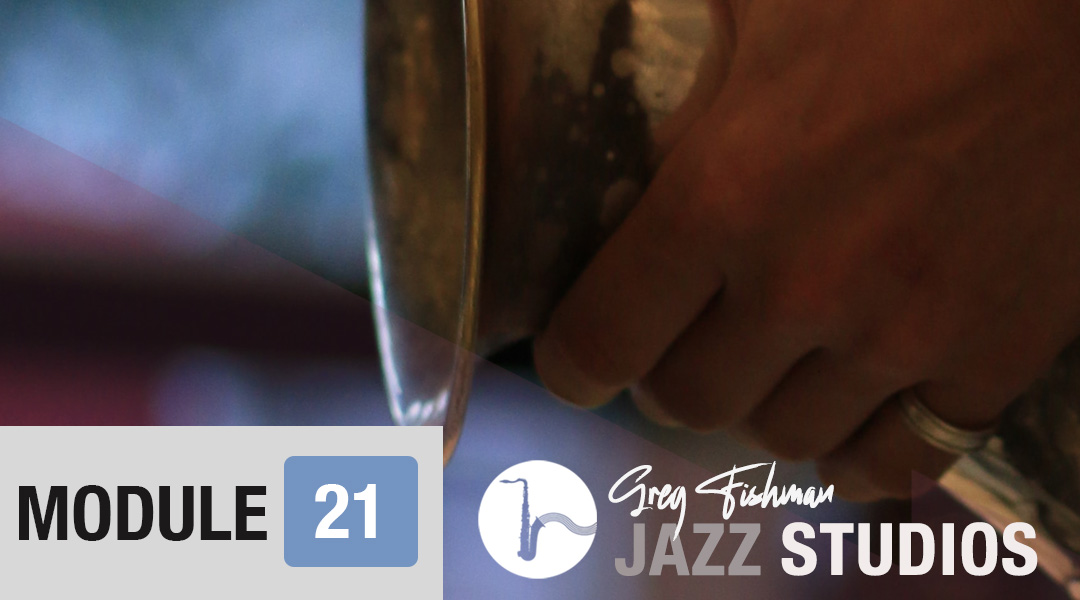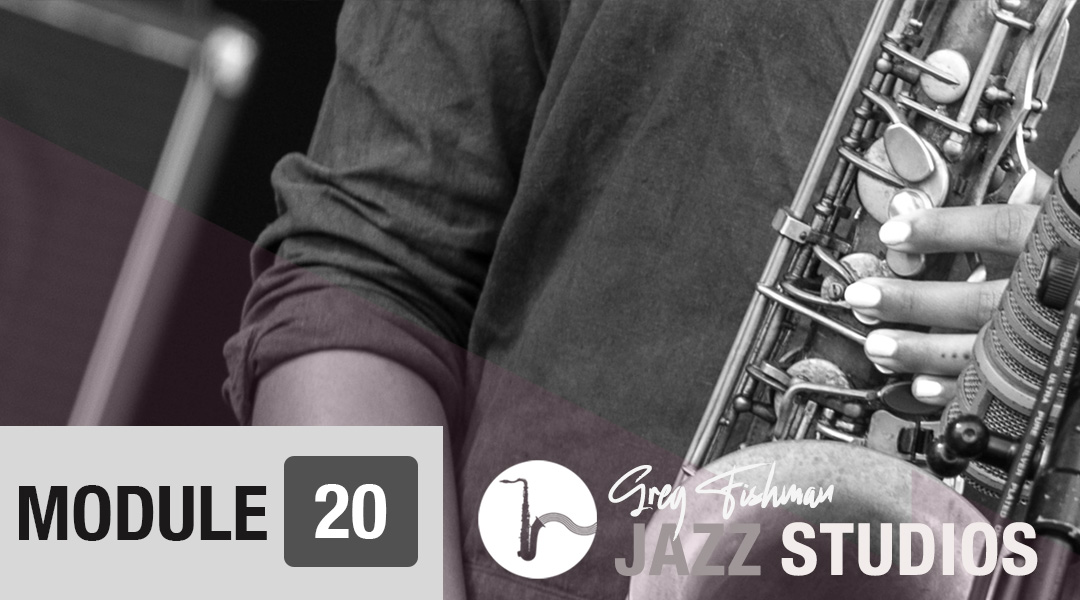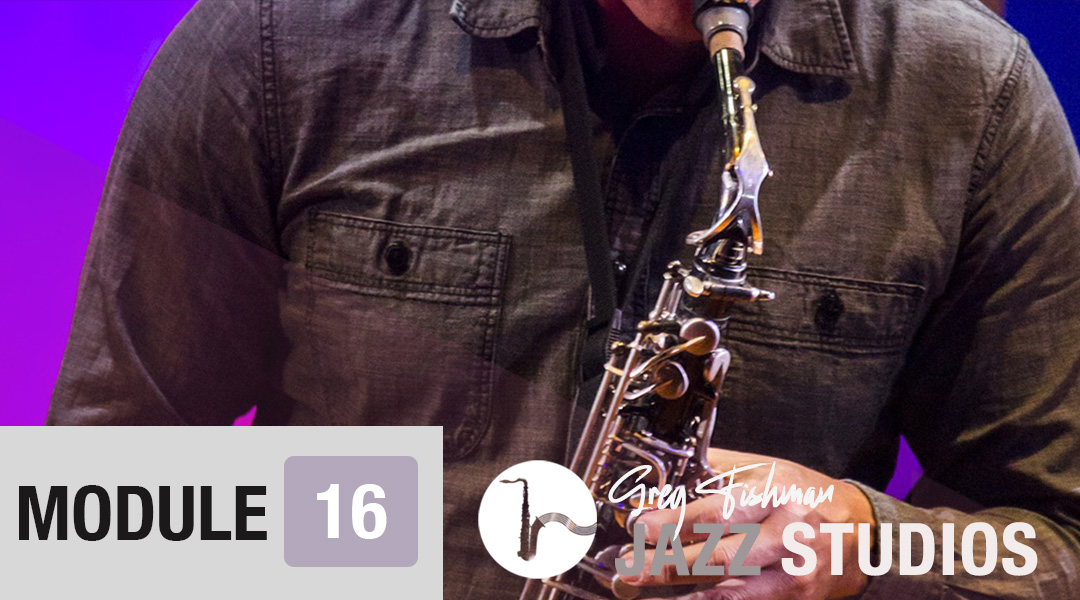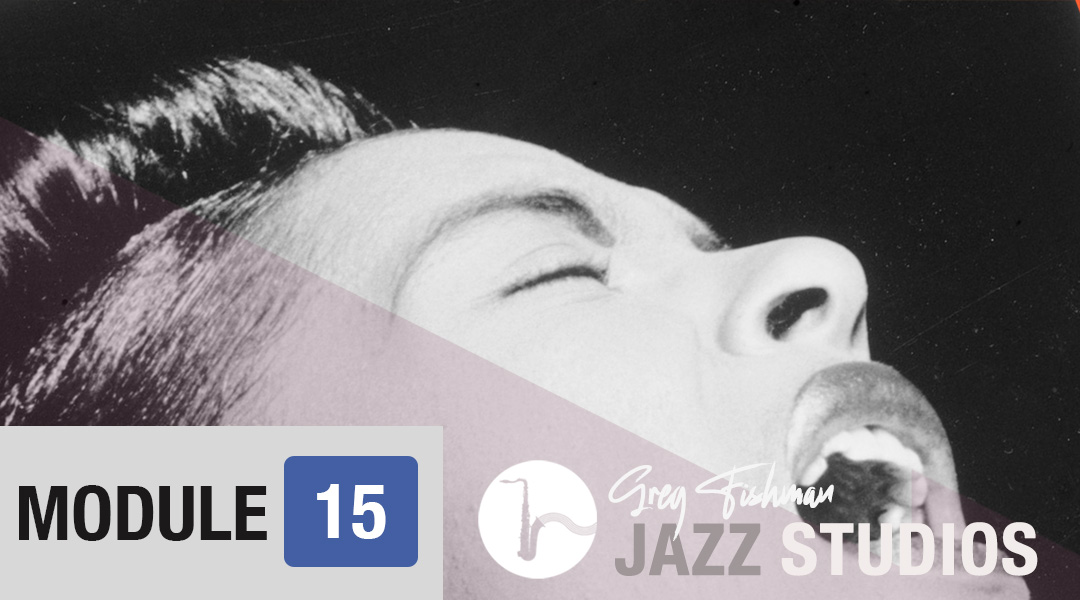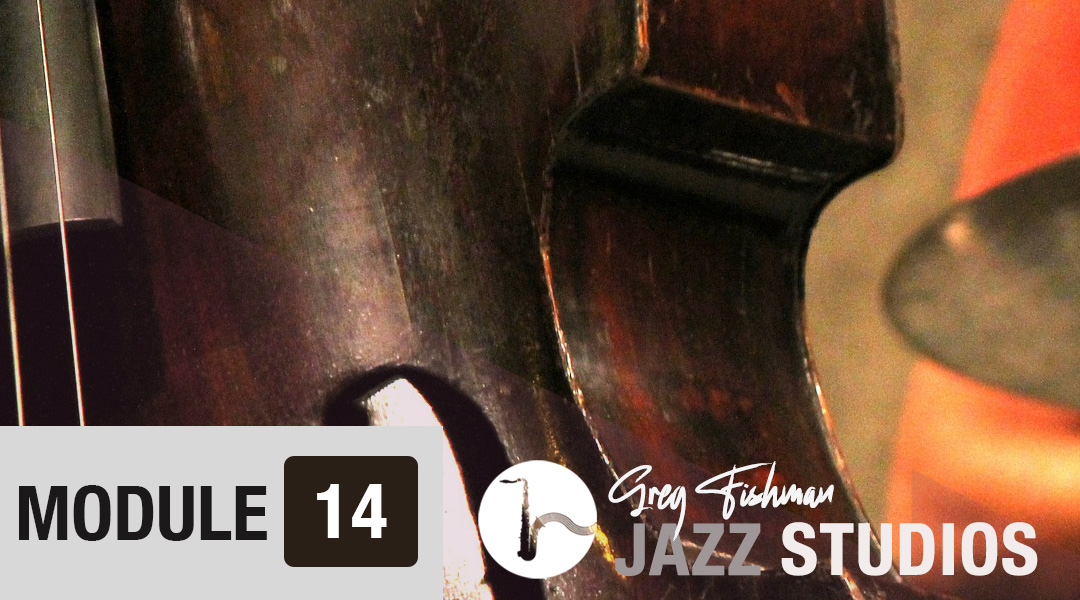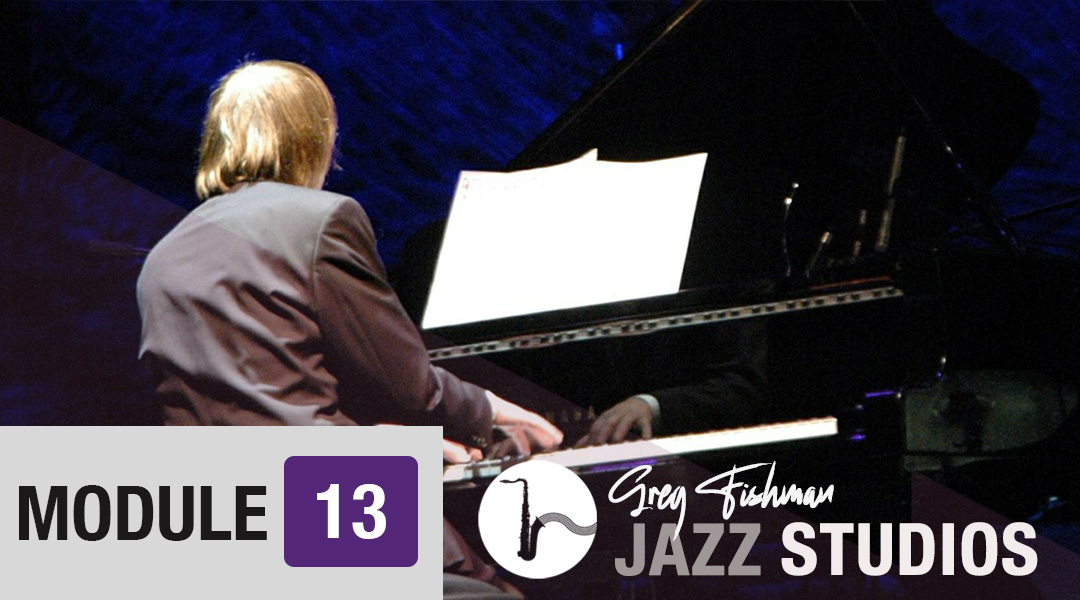5 Lesson course
MODULE 22
5 Lesson course
MODULE 21
5 Lesson course
MODULE 20
5 Lesson course
MODULE 19
6 Lesson course
MODULE 18
5 Lesson course
MODULE 17
5 Lesson course
MODULE 16
5 Lesson course
MODULE 15
5 Lesson course
MODULE 14
MODULE 23
5 Lesson course
MODULE 22
5 Lesson course
MODULE 21
5 Lesson course
MODULE 20
5 Lesson course
MODULE 19
6 Lesson course
MODULE 18
5 Lesson course
MODULE 17
Module 23
This video lesson starts with a demonstration of the lick played in several keys, followed by a step-by-step approach showing you how to create the lick.
In this video lesson, I explore the traditional way the modes are taught and then demonstrate my system of playing all of the modes “sandwiched” between a low and high C.
In this video lesson, I share an approach to working with the metronome in which the metronome is an active, rhythmic part of the solo. I have the metronome clicking on 2 & 4, and I make up a solo based on the chords of “Take the A Train.”
In this video lesson, I show you my technique for hearing the metronome on beats two and four.
In this video lesson, I discuss one of my favorite Dexter Gordon albums.
Module 22
In this video, I share what I consider to be the six essential elements needed to sound like a professional player. I demonstrate the elements through an original blues tune, titled “The Six of Diamonds.”
In this video lesson, I share my approach to breathing. If you’ve ever felt short of breath while playing or felt that your tone was a bit thin, this lesson is a must. In addition to the technique of breathing, I also discuss jaw position on the mouthpiece while breathing, as well as my thoughts on long tones. ALL LEVELS. Includes PDF text notes with bullet-point lesson summary.
In this video, I share my approach for getting more impact from short notes. There is a big distinction in the way that a pro player approaches short notes in the middle of a phrase.
The issue is whether the short note is slurred into or tongued as it is played. I demonstrate the two approaches and provide examples to help train your ear to clearly hear the difference between a “low impact” and “high impact” short note. If you want pro-like short notes in your lines, this lesson is essential, and a total game-changer. ALL LEVELS. Includes PDF lesson notes.
In this video, I share my system for learning and practicing diatonic triads. These triadic chord structures often get overlooked, but they’re essential for all players.
In this video lesson, I share some of my thoughts about the innovative way in which Stan Getz introduced the new Bossa Nova style to the world. Also includes a short demo of Getz playing diatonic triads.
Module 21
In this video lesson, I share my unique system for learning the cycle by combining two whole-tone scales. While I’ve shared this concept of using these scales in a previous video, I’ve had many requests to demonstrate my “shuffled cards” analogy on camera.
Speedbag with Major 2nds
In this video lesson, I work with page 23 from my book, “Intervals in Action,” to show you how I use the “speedbag” technique with Major 2nd intervals to increase and improve the speed, accuracy and control of my technique on the saxophone. INTERMEDIATE & ADVANCED LEVEL. Includes a PDF of the page from the book that was used in the video.
In this video lesson, I demonstrate many different practice strategies for working with Section 1 of the book “Intervals in Action.” Topics covered include: Creating new rhythms, playing the intervals in a 5/4 time, playing in retrograde (backwards), playing in tritone pairs, and more! Includes a PDF of the full page used in the video lesson. INTERMEDIATE & ADVANCED.
In this video lesson, I’ll show you how to work with Hip Lick #5 from my book, Hip Licks for Saxophone, Volume 1.
In this video lesson, I discuss some of my favorite elements of these two amazing player’s styles.
Module 20
This is part one of a two-part video lesson which I call my “Mind Transcription” series. In this series, I share my ideas and strategies for soloing over the chords of popular standards and jazz tunes.
This is the second part of the lesson. Includes discussion of note groupings and use of sequence.
In this video lesson, Greg shares his unique system for teaching the Cycle (also known as “the Circle of 4ths” or “the Circle of 5ths”). Understanding the Cycle is essential for the development of all aspiring musicians. Includes Hip Lick #1 played in the Cycle in 12 keys, plus detailed PDF lesson notes for C, Bb, and Eb instruments. INTERMEDIATE / ADVANCED LEVEL.
In this video lesson, I’ll show you how to work with Hip Lick #10 from my book, Hip Licks for Saxophone, Volume 1. This is a ii mi7 – V7 lick often used by Charlie Parker.
This video lesson explores minor 3rd intervals in many different harmonic contexts with a particular focus given to the way that the interval is used by Jobim in his classic Bossa Nova, “The Girl From Ipanema.” Includes a PDF of page 65 from the book “Intervals in Action,” featuring 31 different harmonic applications of the minor 3rd.
Greg discusses the classic album, Gene Ammons – Boss Tenor
Module 19
This is part one of a four-part video series in which I call my “Mind Transcription” series. In this series, I share my ideas and strategies for soloing over the chords of popular standards and jazz tunes.For this lesson, I’ve chosen the changes for Blue Bossa.In part one of this four-part lesson, I comp the chords at the piano, discuss the importance of hearing the chords at the piano, explore and explain voice-leading strategies from both the 7th and the 5th, and start the analysis of my original solo over the changes. I also discuss my thoughts about playing the roots of the chords over your solos.PDF practice materials to be used with all four parts of this lesson are attached to this video lesson. Materials include:
2. The solo I created on the changes of Blue Bossa
3. MP3 play-along tracks (short demo version and long rhythm-section only version)Includes PDFs for C, Bb, and Eb instruments.
Part 2 of 4 continues with an in-depth analysis of the solo, advanced voice-leading moves. This portion of the lesson ends at the half-way point in the solo (includes letters A through B).
In part three of this lesson, the theoretical analysis continues from letter C of the solo. I discuss “high mileage” from using major second intervals in multiple harmonic settings.This portion of the lesson also includes a brief discussion of the diminished scale and diminished whole-tone scale.
PDF practice materials, including three voice-leading example sheets, the solo, and mp3 play-along tracks, are attached to Part 1 of this lesson. Includes music for C, Bb and Eb instruments.
In this fourth and final part of this video lesson on the chords of Blue Bossa, I discuss the harmonic minor scale as used in the solo and give some voice-leading practice assignments and suggestions.
PDF practice materials, including three voice-leading example sheets, the solo, and mp3 play-along tracks, are attached to part 1 of this lesson. Includes music for C, Bb, and Eb instruments.
In this video lesson, I show you what I call the “double enclosure.” I add lower and upper neighboring tones to add heightened chromaticism to the enclosure. This creates a sort of musical “zig-zag” effect which is really fun for the ear.
Includes PDF lesson notes for C, Bb and Eb instruments. INTERMEDIATE & ADVANCED LEVEL.
In this video, I’ll show you how to take a common chord exercise of diatonic 7th chords, transforming them into a swingin’ phrase full of rhythmic drive with stylized elements of dynamics, articulation, and vibrato.
This is a fun, simple exercise that can really improve your time feel. Includes detailed PDF lesson notes in C, Bb and Eb. INTERMEDIATE LEVEL.
Module 18
In this video lesson, Greg shares his method for applying lower and upper neighboring tones to a minor seventh chord. This approach provides a simple way to melodically enhance the chord. If you’ve been bored with the same old way of practicing your chord arpeggios, this video lesson will bring new life and energy to your practice sessions. INTERMEDIATE & ADVANCED LEVEL. With detailed PDF lesson notes for C, Bb, and Eb instruments.
In this video, we explore a great Coltrane device for transforming a common scale pattern in thirds to a very hip jazz phrase by adding lower neighboring tones to the lower notes in the groups of thirds. Very easy to play, and a very high cool factor! INTERMEDIATE LEVEL. Includes PDF lesson notes for C, Bb, Eb Instruments.
In this video lesson, Greg shares his unique system for teaching the Cycle (also known as “the Circle of 4ths” or “the Circle of 5ths”). Understanding the Cycle is essential for the development of all aspiring musicians. Includes Hip Lick #1 played in the Cycle in 12 keys, plus detailed PDF lesson notes for C, Bb, and Eb instruments. INTERMEDIATE / ADVANCED LEVEL.
In this video, Greg plays the six note tape measure® scales in all four directions (up, down, up/down, and down/up). He also discusses and demonstrates some of his own practice strategies, such as playing them high-speed and also playing them very slowly. Includes PDF for C, Bb, and Eb instruments. INTERMEDIATE & ADVANCED LEVEL.
Greg shows how to keep your mind focused and sharp even when you’re away from the horn. This music theory game involves thinking of the note “G” as different degrees of major scales.
Module 17
In this video lesson, I show you how to use the Locrian mode in a new setting, over a dominant chord (in addition to using it over a mi7b5 chord). I call this approach “Modes of Modes,” because it gives you the flexibility to apply any mode to a different chord by taking the entire scale and placing it on notes other than the root of the chord. If you’ve ever thought to yourself, “Why do I even need the Locrian mode…I can only use it over mi7b5 chords,” this video will immediately show you how you can use this great sounding mode overall dominant chords. It will really open up your hearing. Includes PDF lesson notes. INTERMEDIATE LEVEL.
In this video lesson, I’ll show you how to play an ostinato bass pattern (a short, repeated theme) and take solo breaks. This is a really fun and effective way to improve your sense of time, your groove and your ability to improvise over a two or four measure solo break. This style of playing is also very effective if you ever want to play unaccompanied solo saxophone. It teaches you how to switch between performing the role of the rhythm section and the role of the soloist. Includes detailed PDF lesson notes. INTERMEDIATE / ADVANCED LEVEL.
In this video lesson, I’ll show how to use a device called a “pedal,” which will instantly transform your scales into very catchy, melodic phrases for use in your improvised solos. I call this approach “high melodic mileage,” because it helps you to find many more melodic uses the scales. The pedal helps to break up the monotony of the scale by highlighting lager intervals. The pedal also lends itself to naturally creating rhythmic interest in your lines. Includes PDF lesson notes. INTERMEDIATE LEVEL.
In this video, I demonstrate the four note tape measure scales. This is the first four notes of each major scale, played in the cycle. I play the four notes in four direcitons: 1. Up 2. Down 3. Up/Down 4. Down/Up. I also discuss and demonstrate some different phrasing techniques for the four note scales, as well as playing each grouping twice for a technical workout. Includes PDF Lesson notes. INTERMEDIATE & ADVANCED LEVEL.
In this video, I demonstrate the five note tape measure scales. This is the first five notes of each major scale, played in the cycle. I play the five notes in four direcitons: 1. Up 2. Down 3. Up/Down 4. Down/Up. I play all examples in 3/4 and in 5/4. Includes detailed PDF Lesson notes. INTERMEDIATE & ADVANCED LEVEL.
I’m constantly aware of environmental sounds. Whether I’m in my car, listening to the “ding” telling me that the car is starting, a railroad crossing bell, an elevator chime, etc. I connect those sounds with the fingerings required to produce those pitches on my instrument. This can be tricky if you play multiple instruments, so I recommend that you use fingerings for your my primary instrument. This is a fun way to reinforce the location of the sounds you hear in your mind. As you get better at locating these external sounds, you will also improve your ability to locate internal sounds, such as the ones you’re hearing in your mind.
Module 16
This video lesson will help you to improve your ability to play descending chords (7-5-3-1). Many aspiring players have no problem playing ascending chords (1-3-5-7), but playing that same chord backwards (descending) presents a real challenge. In this video, I explain why the descending chords can be more difficult for some players, and I share my unique approach to help you hear your way down the chords. Includes PDF lesson notes. INTERMEDIATE & ADVANCED LEVEL
In this video lesson, I’ll show you how to highlight the third of each chord in a ii / V / I progression to create lines with four different contours. These contours have a powerful effect on the type of melodic line you’ll create. This lesson also shares tips for creating rhythmic and melodic variations in your phrases. If you ever feel like you play good notes in your solos, but your phrases are lacking in clarity of direction, this lesson is exactly what you need to take things to the next level. Includes detailed PDF lesson notes. INTERMEDIATE LEVEL
In this video lesson, I’ll show you how to work with Hip Lick #7 from my book, Hip Licks for Saxophone, Volume 1. This is a ii mi7 – V7 lick. It’s a one-measure lick with a nice seven-to-three voiceleading move included. Very easy to play, and it nails the changes. Includes tips on hearing the roots of the chords while playing the lick, working the lick in 12 keys and creating a nice variation on the lick. PDF lesson notes included. INTERMEDIATE LEVEL.
In this video, I demonstrate the four note tape measure scales. This is the first four notes of each major scale, played in the cycle. I play the four notes in four directions: 1. Up 2. Down 3. Up/Down 4. Down/Up. I also discuss and demonstrate some different phrasing techniques for the four note scales, as well as playing each grouping twice for a technical workout. Includes PDF Lesson notes. INTERMEDIATE & ADVANCED LEVEL.
Greg shows how to keep your mind focused and sharp even when you’re away from the horn. This music theory game involves thinking of the note “D” as different degrees of major scales.
Module 15
In this video lesson, I share a concept that I developed after many years of studying the masters. I call it “Tape Measure Scales.” The idea is based on my observations that most people practice scales one octave (or more) in length, but I’ve noticed that this isn’t the way that the scales are actually used when improvising. Professional players can customize the length of any scale to fit any chord, even if the chord is only played for one or two beats. This system will teach you my approach in a step-by-step way, giving you amazing control of your scales. It will also improve your ear, your musical memory and sharpen your mental focus while playing. This is a core item in my own practice sessions. INTERMEDIATE & ADVANCED LEVEL
In this video, I demonstrate the three note tape measure scales. This is the first three notes of each major scale, played in the cycle. I play the three notes in four direcitons: 1. Up 2. Down 3. Up/Down 4. Down/Up. I also discuss and demonstrate practicing the scale slowly, for ear training, as well as a demonstration of playing the three note scale very quickly, for use as a technique workout. INTERMEDIATE & ADVANCED LEVEL.
In this video, I share my unique approach to teaching the jazz style vibrato. This is very different from a classical style vibrato. Many classical players favor a steady, contant speed when using vibrato. However, the jazz vibrato is usually variable in speed, and it often employs a decrescendo as it speeds up. I demonstrate how to practice separating the sound of the air from the sound of the note and then put all of the parts together, playing a couple of phrases of familiar melodies, using the vibrato. INTERMEDIATE AND ADVANCED LEVEL.
In this video, I’ll show you a way to clearly bring out the sound of a ii/V/I progression using just the notes of a descending major scale. This approach works because it takes key notes in the scale and aligns them so that the 3rds and 7ths of the chords are hit at just the right time. I also show how to add the bass notes in the low register of the horn, so that you can combine the root movement with the descending scale. Great for ear training, and also a very practical way to get more musical mileage out of your major scales. INTERMEDIATE LEVEL.
In this video, I share a view of my personal record collection. I discuss the importance of having a high quality stereo system, as well as the importance of being able to listen to an entire album in one sitting, with no distractions of web-surfing, texting or facebook. To me, listening to an album is like listening to a set of music at a jazz club. There will be many more future album recommendation videos, but the Nancy Wilson/Cannonball Adderley album would be at the top of any great player’s list of essential listening.
Module 14
In this video, I share my system for practicing the chromatic scale the full range of the saxophone. This is a fun one, and it will give you very smooth technique, as long as you have the patience to follow step by step, adding one note at a time, as I describe in the lesson. INTERMEDIATE & ADVANCED LEVEL.
In this video lesson, I show you how to take the diminished scale to the next level, playing it in 3rds over a V7b9 chord. This has a very cool, edgy sound which always reminds me of one of my old teachers, the great Joe Henderson. Although this may sound complex, I really break it down into simple steps in the video. The PDF lesson notes provide a very thorough practice guide for the lesson. INTERMEDIATE/ADVANCED LEVEL
In this video lesson, I work with lick #25 from Hip Licks for Saxophone. This is a very cool major 7th lick. I play the lick and then break it down into separate parts, making it very easy to understand. I also share a fun analogy about the importance of developing your musical memory, so that you can compare two musical phrases with very slight differences between the two versions. I also play the lick in twelve keys, descending in half-steps. At the end of the video, I share some advanced concepts for working with the lick. PDF dowload materials include detailed notes and the lick written in all twelve keys. INTERMEDIATE/ADVANCED LEVEL
Many group members have asked me to create a video in which I demonstrate some of my practice techniques for working with the book, Tasting Harmony. In this video, I explain the concept of the book and demonstrate many different ways of working with the play-along tracks. The extras with this video include several pages from the book, some of the exercises from the video, plus the mp3 tracks. ALL LEVELS.
Greg shows how to keep your mind focused and sharp even when you’re away from the horn. This music theory game involves thinking of the note “A” as different degrees of major scales.
Module 13
In this video lesson, I take you though my system for practicing the Dorian scale. You may already know the scale, having learned it the traditional way, as the second mode of a major scale, going from the second note of the major scale to the ninth note. While that method does give you the right notes for Dorian, it doesn’t really train the ear to hear the upper extensions of the minor chord contained within the scale. With my system, your ear will be trained to hear the difference between the sound of the 9th, 11th and 13th. This is a really fun system, and in addition to great ear training, it’s also good workout for your technique. If you already know the Dorian scale, you should watch this video to experience the sound of the scale in a new way. If you’ve never learned the Dorain scale, this is the best way to get started! INTERMEDIATE LEVEL.
In my 20’s, I was transcribing many hours each day. I got tired of putting down the pencil and picking it up again to write a just few more notes. For the sake of efficiency, I just started to hold on to the pencil, even when I was playing the horn. To my surprise, it really helped my technique. Holding the pencil dramatically improved my hand position on the horn. In this lesson, I’ll take you through the process of practicing the “pencil trick,” and also share a few other crazy strategies that I’ve used to getting my fingers in a better position on the horn. INTERMEDIATE LEVEL.
In this music theory video, I’ll take you through from the very basic application to of the tritone sub, all the way through the relationship between altered notes on the native V7 chord and extensions of the tritone substitute. PDF extras include scans of the actual sheets I created during the filming of the video lesson. INTERMEDIATE & ADVANCED LEVEL
Many group members have asked me to create a video in which I demonstrate some of my practice techniques for working with the book, Tasting Harmony. In this video, I explain the concept of the book and demonstrate many different ways of working with the play-along tracks. The extras with this video include several pages from the book, some of the exercises from the video, plus the mp3 tracks. ALL LEVELS.
Greg shows how to keep your mind focused and sharp even when you’re away from the horn. This music theory game involves thinking of the note “E” as different degrees of major scales.
Module 12
Two Great Approaches to Fluency in All Keys – In this video lesson, I’ll share a practice concept which has been great for the development of my playing fluently in all twelve keys. Many are familiar with what I call the “1 in 12 approach.” With this approach to practicing in twelve keys, you take one lick, pattern or song, and play it in 12 keys. However, the “12 in 1 approach” is the reverse…You take twelve different licks and put them all into just one key. This gives you a LOT of material under your fingers in one particular key, and it really improves your hearing in a particular key center. Both approaches are vital, but this 12 in 1 approach is new for most players. Give it a try! I’ve included PDF’s with the 12 in 1 approach for all keys for the first 12 licks of Hip Licks. However, do try them by ear for the best results! INTERMEDIATE & ADVANCED LEVEL.
In this video lesson, I’ll show you how to apply the diminished scale over the V7 chord in a ii-7/V7/Imaj7. This is a great video to watch if you’ve always wondered just how to implement the diminished scale in a moving phrase. First, I’ll play the idea diatonically, using just the notes of the major key. Next, I’ll explain and demonstrate, how to use the notes of the diminished scale in the phrase. In this video, I teach the lesson while playing the examples on the VIBRAPHONE. The vibraphone is great for this type of training, because it’s visual, making it easy to see what I’m doing as I give harmonic analysis. The vibes are also great for working on your saxophone intonation. When you play along with the vibes in the video, you can easily hear if you’re out of tune, because the sound of the vibes is such a pure tone. In addition, the vibes, allow you to hear multiple notes at once, which is great for hearing in harmonic context. PDF NOTES include transposed examples for all C, Bb and Eb instruments. INTERMEDIATE & ADVANCED LEVEL.
In this video lesson, I explore four different fingerings for middle Eb on the saxophone. The old-school players like Dexter, Stitt, Getz, Coltrane, Etc., liked to customize the timbre of their notes. Developing the ability to customize the weight and timbre of your notes will add a pro-level touch of detail to everything you play. If you’re not taking advantage of these four middle Eb options every time you play your horn, you’ve been missing out. Join in the fun with these cool sounds! INTERMEDIATE LEVEL.
In this video lesson, I’ll show you how to apply the major 7th interval to one of my favorite harmonic settings, using the notes of the interval as the 3rd and #9th on a dominant seventh chord. While this is not technically difficult to play, harmonically speaking, for some players, it will take the ear a little bit of time to get used to the sound. In the video, I demonstrate the sound several different ways, so that it’s easy for your ear to hear the interval in this new setting. I first heard Sonny Stitt use this sound when I was learning to play, and have used it ever since. This sound will add a very nice harmonic edge to your playing. INTERMEDIATE & ADVANCED LEVEL.
Greg shows how to keep your mind focused and sharp even when you’re away from the horn. This music theory game involves thinking of the note “B” as different degrees of major scales.



